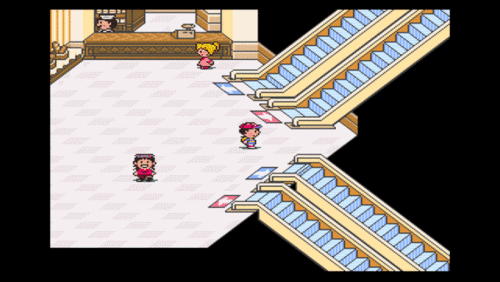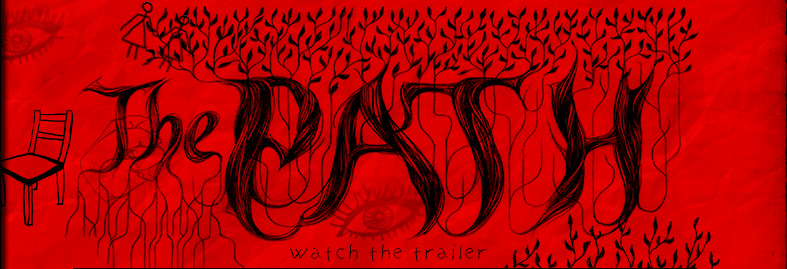In
my last post, I summarized the content theory. Simply put, many game reduce everything you can experience to "Content", which is meant to be consumed and reward you for consuming it. Designing a game-world to make the protagonist happy leads to games with a naive and solipsistic world-view that is often at odds with their serious stories. Here are some games that reject or oppose that.
You take control of a girl in her room. She can sleep, play video games, work at her desk, or go out to her balcony. She refuses to leave.
However, if you go to sleep, you enter a version of your room where you
can open the door and walk out. If you do, you find yourself in an enormous mega-labyrinth of interlinked dream-worlds. The core sense of horror and surrealism in these dream-worlds comes from the feeling that they are not made for you.
The game is about wandering, lost, through enormous broken levels. Some force you to walk through giant black voids without landmarks. Others confuse you with cyclical layouts that loop endlessly. You might find the exit by walking between two stones, or interacting with a flower an odd number of times. There is the feeling that you've fallen through the map, into broken geometry you were never meant to cross.
There are many pieces of content that were clearly designed never to be found: Genuinely secret secrets. One monster has a 1 in 47 chance of being summoned whenever you flip a certain light switch. One door opens if you pass it three times, then turn back.
More thoughts here.
Earthbound was one of the first games to capitalize on the casual surrealism of JRPG's. It discovered a rich vein of weirdness that has since been mined by everything from
Space Funeral to
Anodyne. The quests are bizarre. Like in a dream, your reasons for doing anything dissolve when you try to explain them.
At first this dream-like atmosphere feels warm and charming. Slowly, though, over the course of hours and hours, you begin to get a sense of deep malice. It's not something you can put your finger on - most examples I can give will sound like trivial frustrations. But as you go on, the logic of the dream world slowly transforms into a nightmare that you feel trapped in.
At one point, you are suddenly transported to Moonside, a inverted version of the town you're traveling through. The buildings glow neon, the inhabitants slur broken speech at you, and pieces of abstract art constantly attack you, even indoors. Being trapped there is nauseating; even worse is the way you have to follow the broken logic of the place to escape it. Internalizing it's crooked rules feels somehow corrupting.
The game suddenly and randomly transports you to a terrifying inverse world like this twice in a short space of time. The effect is a feeling that this darkness underlies everything, everywhere. Later, as you navigate the dream logic of another quest, you start to feel like you never really escaped Moonside.
There are flowers in the forest. A counter on your screen tells you how many you've collected, out of 144. If you collect all 144 flowers, absolutely nothing happens.
That is
vicious. I can't defend it.
The "Good Ending" of Spec Ops: The Line is to turn off the game. The longer you continue, the more you descend into increasingly horrific and unnecessary war crimes. The content you consume is repulsive: the combat itself is deliberately designed as an endless slog that slowly numbs you to all sensation. The game wonders aloud whether playing it is a morally questionable act: "To kill for entertainment is harmless," reassures one of the loading screen tips.
It largely exists for people who play Call of Duty without questioning its values. The game was marketed as a straight Military Shooter: The box offers no indication that it will slowly and surely become a nightmare. I can imagine that it reached a lot of COD-playing twelve year olds, who must have been traumatized to find their escapist killing suddenly become messy.
A 50,000 word long discussion of Spec Ops here.
Horror games in general
If a horror game is at all successful, you won't want to consume content. The genre expectations completely invert the philosophy of modern game design. As soon as you realize that a game is a horror, you expect that consuming content will not be traditionally enjoyable. You judge that the game has succeeded if you don't want to fight the monster or enter the new level. This means horror games are celebrated for things that would be seen as terrible game design anywhere else. Thank god they exist.
You wake up in your apartment. The door is locked: There's a hole in the wall that leads to a nightmare. You slowly explore this nightmare world, returning to your room as a safe place to rest and heal. At one point, someone offers you an item. You can take it, or refuse it. Obviously, you're going to take it - that's the way games work. Items are there to be picked up.
If you do, a nightmare creature invades your room. Your safe place is violated. Nothing is sacred, nowhere is safe.
I use this game as a modern stand-in for every classic RPG from fallout to the OSR way of running D&D. If you go to certain places, you will find monsters too terrible for you to fight. These places are not made for you: you are not welcome here. This feeling is temporary, of course: The games pretend that a place hasn't been designed for your benefit so that it feels all the more satisfying to come back when you're at the right level, and slot into your correct place.
The same feeling is captured in Metroidvania games. Classically, you'll have to jump around lava pits before unlocking lava-proof shoes. When you get that item, you've suddenly turned the world into something that's designed to be convenient for you. It's like turning a jungle into a department store with the flip of a switch.
More here.
The world is made for your enemies: You have to skulk around the edges of it, distort it to your own purposes, and penetrate it.
So.
I worry that I haven't expressed this anti-content idea well, even after these two articles. It is, essentially, the idea that a game shouldn't make you happy: that the things in a game should not feel like they've been made for you; that the sickening feeling that you've done the wrong thing is just as valuable as a pat on the head. It's an advocation for games that are bewildering, broken, twisted and immoral. It stands alongside the philosophy of fun games, not against them. These ideas might be obvious, but they're important to the way I think about games.













